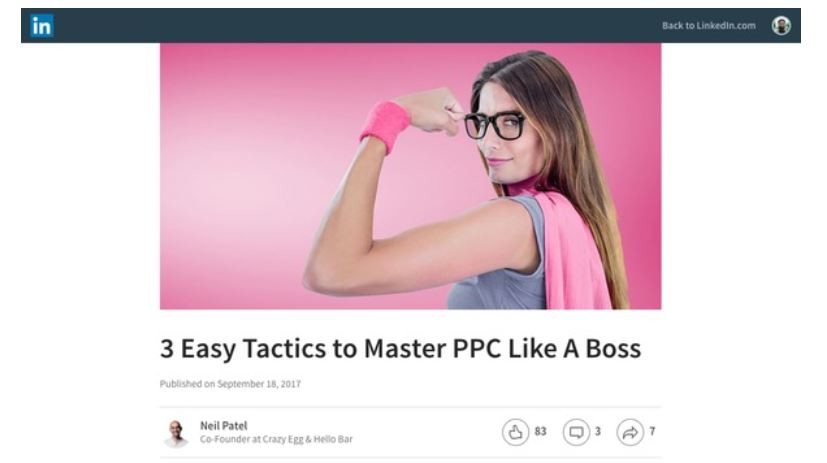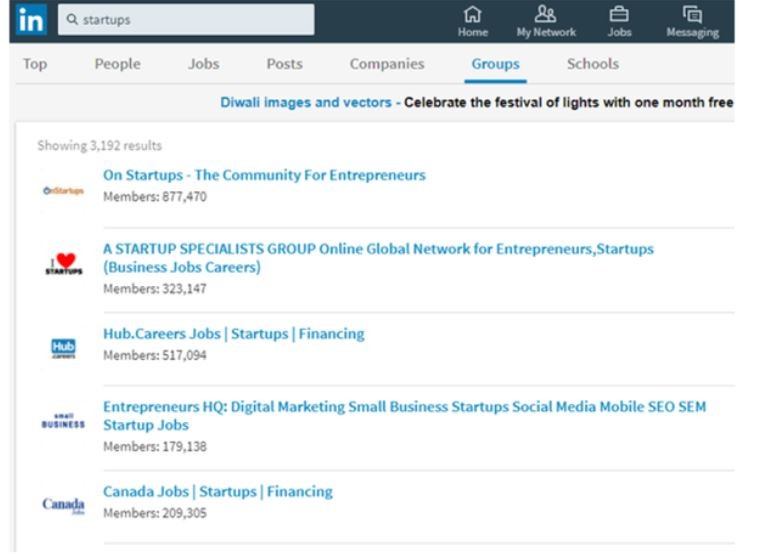
Over the last year and a half, I have managed the Microsoft Partner Network social channels (Twitter, Facebook, LinkedIn, YouTube) and host our podcast channel found ( iTunes). Social media gives well recognized brands or small businesses a platform to engage with their customers and humanize your product or service. You not only can nurture your relationships with the existing audience, but you can also use social media to find and convert valuable leads. This is where the buzz word “social selling” comes into play, and has been a huge area of focus for me over the last year. At the end of the day, we are trying to connect with customers, deliver value and hopefully drive conversions. So if social media can actually drive conversions, we’re onto something very interesting.
After conversations with LinkedIn, Microsoft Inside Sales, Microsoft Dynamics, and various industry experts, here are 7 essentials to becoming a social seller.
1. Look Your Best
Your image is just as important in the digital world as it is in the real world. Online, your profile image is the first thing prospective clients and connections will see. Make a good impression with a professional image that isn’t too stuffy, but still makes you look trustworthy and friendly.
The copy in your bio on any social network has to accomplish everything a greeting, handshake and an elevator pitch would do in person. Write every word with your prospect in mind and write in the first person, not the third. And be sure to be very clear about sharing your contact info. Share multiple avenues if there is room.
On a site like LinkedIn, where you have more real estate to expand upon in your summary section, tell a story about who you are, why you do what you do and how you can help. Remember, LinkedIn is different from a resume. Use your headline not just for your title but for a short phrase explaining how you help your clients and what your expertise is.
Make sure you also highlight your expertise by getting your colleagues, clients and employees to endorse you for all the skills you have and write recommendations. These skills will be featured prominently in your LinkedIn profile.
2. Build Your Credibility
Your company might have a solid reputation, but do you? Social networks can help you build your personal brand which can elevate the company’s brand. With every Tweet, LinkedIn comment, Facebook post, podcast interview or blog, you can grow your reputation and establish a solid foundation.
It’s a great record of your authenticity and a great place to demonstrate your understanding of your industry and potential clients. This can be achieved by sharing relevant articles about your industry, adding thoughtful insights to conversations and solving problems your prospects may have. It’s all in the name of establishing trust. When you share interesting thoughts, others will re-share them, tag you or start a conversation with you.
You can even use LinkedIn’s publishing platform to write original articles relevant to your industry. In fact, this is one of the tactics Neil Patel uses to share his marketing expertise and funnel traffic back to his website.

Another way to build credibility and social proof on LinkedIn is to ask for recommendations or endorse others in hopes that they’ll endorse you back. Lastly, encourage your network to share and comment and get the conversation started around you. And make sure you do that back! Give everyone some love when they’re sharing great insights.
3. Track Results of Your Existing Social Selling Efforts
The best way to get better at social selling is by learning from your existing efforts. Collect insights from your current efforts and see what’s effective as well as what isn’t. Based on this data, ask yourself what you should be doing differently and what you can do better. This can help you gain a clearer direction of how you should change and adapt your efforts to deliver even better results. For example, maybe you’re tracking the activity of your social media referrals and you found that a majority of them leave within seconds. This might be a sign that there’s something wrong with your landing page, and you should take a closer look to see how you can improve it.
Although it can be challenging to understand how social media referrals are behaving on your site or with your own content, there are many tools that can make a huge difference. We use Sitecore for our primary website as well as Sprinklr for social media listening, engaging and measuring. There’s also LinkedIn Elevate which is an employee advocacy and curation tool that does a nice job of tracking your engagement. Keep an eye on which pages your visitors from social media are viewing and what they engage with the most. It will also give you insights into the organizations those visitors belong to.
This data can help you identify your warmest sales leads and which of your content interests them the most. And with this information, you’ll enhance your messaging so that it appeals to them and delivers better results.
4. Participate & Engage in Relevant LinkedIn Groups
LinkedIn Groups are an excellent source of prospects for B2B companies. All you need to do is find relevant groups, submit a request to join, and start conversing with members once you get accepted.
You can share your valuable expertise and content, ask relevant questions or engage with group members to build a relationship.
This relationship that you’ve formed with relevant prospects through LinkedIn Groups can be crucial for nurturing them as leads. You can inform them of new product launches or recommend relevant services that they seem to need based on their conversations

5. Find Your Prospects
Social networks are a great place to learn more about your potential clients. Pay attention: where do your potential clients turn to seek more information about problems they may have? Is it a LinkedIn group? A weekly Twitter chat? A private Facebook Group? Plant yourself there, listen to their conversations and get involved.
While LinkedIn is the place to turn for business connections, Twitter has a much better search function and has a lower barrier to entry. You can follow anyone you want, from a CEO to a celebrity, and they don’t have to accept your request as they do on LinkedIn or Facebook. They might even follow you back.
You can also use the Twitter Chat Schedule on Tweet Reports to discover upcoming and/or trending Twitter chats. Look through conversations relevant to your industry, join in on the chat, and start following the best prospects. We started our own #PartnerPulse Tweet Chat every month, and have seen incredible engagement amongst partners and partners with Microsoft. Again, it’s all about humanizing the experience.
On Twitter, search certain industry-specific hashtags to see what your potential clients are talking about and what’s important to them. Once you’ve found some prospects, they may be able to lead you to others. For example, see who they are following and start following those people as well. On LinkedIn, some of the best conversations happen in industry-specific groups. Check the profiles of your prospects and see which groups they are a part of, and then join them.
Once you’ve found your prospects, stay organized. You can use Twitter Lists to create personalized public or private feeds, which maximize your time. Create a private Twitter List with your top 25 prospects, or create additional lists for competitors, influencers and current customers. On LinkedIn, you can use Sales Navigator to find, track and engage with leads. It’s an incredible tool.
6. Nurture Your Prospects
You don’t necessarily have to create your own content or fill your feed with generalized tips that appeal to everyone. A crucial aspect to any social etiquette—and especially that of social selling—is to pay attention to and respond to what others are sharing and saying. Social selling isn’t just about aggressively promoting your business on social media. Rather, it’s the way you directly and indirectly promote your business through your social media behavior. And this includes your ability to respond to and resolve customer complaints submitted on social media. You’ll be selling your brand name through exceptional customer service.

When starting a conversation or participating in a pre-existing one on a social network (like a Twitter chat) remember that it’s just that, a conversation. Be sure to listen. Every day you should be leaving comments or ‘Liking’ posts from others. More importantly, respond to people who are trying to reach out to you.
ALWAYS provide value first.
Don’t be like actor Christian Bale, who managed to post just two tweets in six years.

Social networks are a time commitment and this is exactly why. Once you’ve started following the right people, you must continuously provide valuable contributions. So choose your network wisely and don’t spread yourself too thin. Every Tweet, comment and post matters and you don’t want to disappear for weeks at a time. An abandoned network looks careless.
There are plenty of ways to stay active on social media:
- Share your expertise through success stories and use video! Video is the way to do content so don’t be scared and just start a conversation.
- Offer up solutions.
- Always stay focused on the potential buyer.
- Use relevant hashtags on Twitter to target your content more appropriately.
- Follow industry influencers so you stay relevant and up to date
7. Get Offline
If you can convert your social media followers to email list subscribers, that’s a great first step. But what you really want to do is convert these digital friends into real life connections. Social media is a great way to establish that warm connection.
Once you’ve established a back-and-forth conversation with someone on social, it’s easier to suggest a phone call or coffee date via a Tweet or email. Think about it: an email with a subject line referencing your Twitter conversation may be more likely to get opened. Now it’s up to you to make sure your real-life persona is just as great as your digital one.
Conclusion
Hopefully these tips can help you promote your brand effectively through social media, ultimately resulting in loyal customers and increased conversions. When implemented together, these tactics can make a significant difference in your social media performance and more than anything, drive real connections.
Meet me at #SMWATX on February 26th, 2018 where I talk with Joshua B Lee on the Power of LinkedIn and Social Selling.
